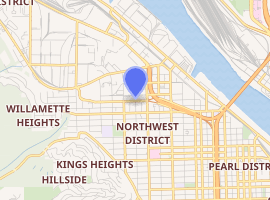Vaughn Street Park
Vaughn Street Park was a baseball park in the northwest United States, located in Portland, Oregon. Opened in 1901, it lasted for over a half century and was torn down in 1956. Its primary tenant was the Portland Beavers of the Pacific Coast League. During a stretch when the club was tagged as the "Lucky Beavers", the ballpark was also sometimes called Lucky Beavers Stadium.
.png) Aerial view from southwest in 1951 - marquee reads "Lucky Beavers Stadium" | |

| |
| Location | NW 24th & Vaughn Portland, Oregon |
|---|---|
| Coordinates | 45.537°N 122.701°W |
| Owner | E. I. Fuller, C. F. Swigert |
| Capacity | 12,000 |
| Field size | Left Field: 331 ft (101 m) Center Field: 368 ft (112 m) Right Field: 315 ft (96 m)[1] |
| Surface | Natural grass |
| Construction | |
| Broke ground | 1901 |
| Opened | 1901 |
| Closed | 1956 |
| Demolished | 1956 |
| Tenants | |
| Portland Beavers (PCL) Portland Colts (NWL) Portland Rosebuds (WCBA) | |

The site, in the Slabtown area, is presently an industrial property with no traces of the stadium, except for a plaque.
History
Built 119 years ago in 1901, it was financed by E. I. Fuller and C. F. Swigert, two owners of trolley lines that ran nearby. The ballpark was on a block bounded by Northwest Vaughn Street on the south (third base), Northwest 24th Avenue on the east (first base), and Northwest 25th Avenue on the west (left to center field). The field had an unorthodox northwest alignment (home plate near the southeast corner), at an approximate elevation of seventy feet (20 m) above sea level.
The two financiers hoped to profit from professional baseball, both at the box office and via fares from their trolley lines. In 1896, Portland's former professional baseball team had folded; a new team, the Portland Webfoots, debuted in 1901. This team would go on to win the Pacific Northwest League title that year. The following year, the league merged with the California League to become the Pacific Coast League; the Webfooters, after several name change, settled on the name Portland Beavers.
Initially, the stadium had a single 3,000-seat grandstand behind home plate; seating was expanded to 6,000 seats in 1905. That year, Portland hosted the Lewis & Clark Centennial Exposition, and the stadium was used for the National Track and Field championships, held concurrently. During that event, baseball was temporarily played on the grounds of the Portland Athletic Club (later the Multnomah Athletic Club), on a field that is now the site of Providence Park. With the construction of additional seating in 1912, Vaughn Street Park's capacity grew to 12,000 spectators.
1920s–30s
In 1926, the stadium received its first serious local competition when the larger and more modern Multnomah Stadium (now Providence Park) opened approximately two miles (3 km) to the south. It was expected that the baseball team, now christened the Beavers, would move to the newer stadium, but the team elected to stay at Vaughn Street. Multnomah Stadium was instead used for other sporting events, including college football and greyhound racing.
Vaughn Street Park occasionally hosted other events besides baseball; several prizefights were held there.[2]
Among the notable players to play at Vaughn Street, either for the home team or for the visitors, are Satchel Paige, Joe Tinker, Jim Thorpe, and Ted Williams.
1940s–50s
The stadium also became, however briefly, the home of the Portland Rosebuds, a team owned by Olympic gold medalist Jesse Owens.[3] The Rosebuds were part of the West Coast Baseball Association, an all-black league headed by Abe Saperstein, the owner of the Harlem Globetrotters; the league was disbanded after only two months.[3]
In 1947, the center field bleachers burned in an early morning fire on September 21, blamed on a smoldering cigarette;[4][5] the stadium had recently been condemned by fire inspectors.[6][7] The center field bleachers were rebuilt, smaller than their predecessor and disconnected from the left field bleachers.
In 1955, the stadium was bought by new owners, who later announced that they would tear it down; the Beavers moved to Multnomah Stadium in 1956. The stadium was razed that same year. The grass field from Vaughn Street was transplanted to Multnomah Stadium; thirteen years later in 1969, artificial turf was installed.
Dimensions
The dimensions were hitter-friendly:[1]
- Left field – 331 feet (101 m), wall 20 feet (6 m) high
- Center field – 368 feet (112 m), wall 20 feet (6 m) high
- Right field – 315 feet (96 m), wall 30 feet (9 m) high
References
Specific references:
- "A History of Baseball in Oregon". Oregon Stadium Campaign. Retrieved 2010-07-31.
- "BoxRec: Venue: Vaughn Street Park". boxrec.com. Retrieved December 4, 2018.
- "West Coast Baseball Association". Organizing Black America: An Encyclopedia of African American Associations. BookRags. 2005-02-10. Retrieved 2010-07-31.
- "Fire destroys Portland seats". Spokesman-Review. Spokane, Washington. Associated Press. September 22, 1947. p. 9.
- "Baseball stands razed by blaze". Spokane Daily Chronicle. Washington. Associated Press. September 22, 1947. p. 15.
- "Beaver stands damaged by fire". Bend Bulletin. Oregon. United Press. September 22, 1947. p. 3.
- "Portland officials may close Vaughn St. after Sunday's fire". Eugene Register-Guard. Oregon. Associated Press. September 23, 1947. p. 14.
General references:
- Portland Baseball from PDXHistory.com
- Vaughn Street Park – Pacific Coast League from the Portland State History Department, including a 1955 aerial photo (Oregon Historical Society OrHi 5908)
External links
| Wikimedia Commons has media related to Vaughn Street Park. |
- Oregon Encyclopedia – Vaughn Street Park